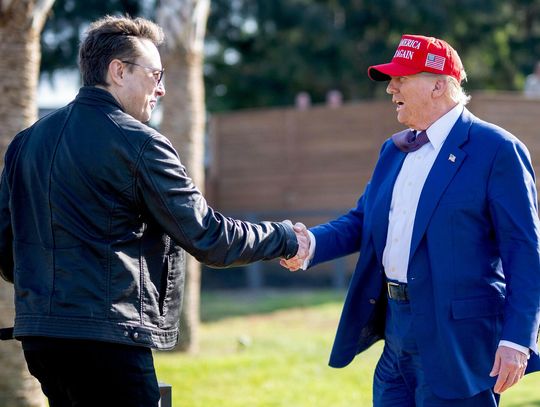Powstanie stałej bazy wojskowej miałoby duże geopolityczne znaczenie nie tylko dla samej Polski i relacji polsko-amerykańskich, ale dla całej Europy Środkowo-Wschodniej. Do obozu zwolenników stałej bazy wojskowej USA w Polsce, oprócz najbardziej zainteresowanej Polski, zaliczają się Litwa, Łotwa, Estonia, Rumunia czy Ukraina, czyli kraje najbardziej zagrożone rosyjską agresją.
Kontekst polityczny
Polska otwarcie proponowała stałą obecność USA od czasu urzędowania prezydenta George W. Busha, a wszystkie znaczące siły polityczne w Polsce wspierają ten pomysł od lat. Wydaje się jednak, że pozytywna decyzja i przejście do etapu realizacji są bliższe niż kiedykolwiek. 18 września 2018 r. podczas wspólnej konferencji prasowej prezydenta Stanów Zjednoczonych i prezydenta RP ogłoszono propozycję zwiększenia zaangażowania armii USA w Europie Środkowo-Wschodniej. Prezydent Donald J. Trump stwierdził, że USA rozważają rozmieszczenie większej liczby amerykańskich żołnierzy i sprzętu wojskowego w Polsce. Jego polski odpowiednik, prezydent Andrzej Duda, zaproponował budowę stałej bazy USA w Polsce. Amerykański Kongres zobowiązał Pentagon do przedstawienia, nie później niż 1 marca 2019 r., raportu oceniającego wykonalność stałego stacjonowania sił zbrojnych Stanów Zjednoczonych w Polsce.
Reakcja na agresję
Stała baza wojskowa USA to działanie w ramach reagowania na istniejącą sytuację. Nie jest to krok ofensywny, lecz obronny. Rosyjski prezydent Władimir Putin jako pierwszy wykonał ruch, rozbudowując militarne zdolności Rosji w bezpośrednim sąsiedztwie NATO. Moskwa nie poprzestała na aneksji Krymu czy okupacji części Donbasu i nadal prowadzi agresywne działania wobec Zachodu (m.in. otrucie Skripala czy inne operacje wywiadu wojskowego).
Wzmocniona obecność wojskowa NATO na wschodniej flance to reakcja na łamanie prawa międzynarodowego przez Rosję. Niestety, niewielkie garnizony Sojuszu, które pojawiły się po 2014 roku, nie są już wystarczającą gwarancją bezpieczeństwa. O intencjach Rosji świadczyć mogą chociażby manewry Zapad 2017. Od wielu lat wiadomo, że najlepszą gwarancją bezpieczeństwa dla krajów zagrożonych agresją Rosji nie są podpisane dokumenty sojusznicze czy papierowe obietnice pomocy. To, co najlepiej chroni, to stała obecność amerykańskich żołnierzy.
Oferta Polski
Potencjał wojska polskiego w służbie czynnej wzrósł ze 100 tys. do 130 tys. żołnierzy, a do 2025 roku ma wynieść 200 tys. żołnierzy. Polska armia przeznacza coraz więcej środków na modernizację oraz zakup sprzętu, w tym w ramach kontraktu na pociski Patriot, wartego 4,75 mld dolarów. Jednak mimo tak znacznego zwiększania potencjału militarnego, Polska wciąż w ewentualnym starciu z Rosją znajduje się w dużo gorszym położeniu.
Nic więc dziwnego, że swój wysiłek militarny chce wzmocnić wsparciem strategicznego sojusznika. Polska wielokrotnie wspierała Stany Zjednoczone, czego najlepszym przykładem jest zaangażowanie w wojnę w Iraku i Afganistanie. Dlatego też Polska ma prawo oczekiwać wzajemności, tym bardziej, że tutaj korzyści osiągają wszyscy.
Dowodem na determinację strony polskiej jest propozycja wydania przez rząd RP do 2 mld dolarów w ciągu 10 lat na wsparcie obecności wojsk amerykańskich w Polsce. Co niezwykle ważne, polskie elity polityczne są niemal jednomyślne co do konieczności stworzenia stałej bazy amerykańskiej. Także większość społeczeństwa opowiada się za takim rozwiązaniem.
Korzyści dla USA
Zainstalowanie stałej bazy wojskowej w Polsce, w odpowiedzi na postulat Polski, byłoby bardzo wyraźnym sygnałem dla wszystkich sojuszników USA – nie tylko w Europie, ale na całym świecie. Waszyngton nie ma lepszej możliwości udowodnienia, że opłaca się dotrzymywać zobowiązań sojuszniczych, aby otrzymać takie właśnie, konkretne i trwałe wsparcie USA. Po pierwsze, Polska chce pokryć większość kosztów funkcjonowania bazy amerykańskiej. Po drugie, Polska wydaje na obronność ok. 2 proc. PKB, tak jak powinien każdy członek NATO (a robi to mniejszość). Po trzecie Polska inwestuje w modernizację uzbrojenia, w dużej mierze kupując sprzęt w USA.
Pentagon powinien bowiem brać pod uwagę coraz bliższą współpracę, także militarną, Rosji i Chin. Rośnie więc ryzyko wojny na dwa fronty. Jeżeli nawet przy regularnej wojnie w Azji Moskwa nie zdecyduje się stanąć otwarcie u boku Pekinu, to jest bardzo duże prawdopodobieństwo, że zaangażowanie Amerykanów na Dalekim Wschodzie wykorzysta do uzyskania pewnych celów w Europie. Chociażby rozbicia Ukrainy, aneksji krajów bałtyckich czy nawet uderzenia na Polskę. W takim scenariuszu sama obecność amerykańskiego wojska na stałe w Polsce może powstrzymać Rosję przynajmniej przed agresją na członków wschodniej flanki Sojuszu.
Kwestia strategiczna
Stała baza US Army w Polsce to strategiczna kwestia wykraczająca konsekwencjami poza granice kadencji poszczególnych ekip politycznych rządzących w Waszyngtonie i w Warszawie. Stała baza wojskowa USA w Polsce, położona w kluczowym punkcie wschodniej flanki NATO, tylko potwierdza zobowiązania amerykańskie wobec Sojuszu i to, że dla Amerykanów NATO pozostaje najważniejszym środkiem zapewniania bezpieczeństwa i Europie, i sobie samym.
Krzysztof Kamiński
prezes Warsaw Institute
jest absolwentem Uniwersytetu Warszawskiego (bezpieczeństwo wewnętrzne) oraz ukończył kurs w The Institute of World Politics w Waszyngtonie. Doświadczenie zawodowe zdobywał w sektorze energetycznym. Obszary zainteresowań: geopolityka, energetyka i public affairs.
www.warsawinstitute.org
Warsaw Institute to polski think tank zajmujący się geopolityką. Do głównych obszarów analiz należą stosunki międzynarodowe, bezpieczeństwo, energetyka, historia, kultura i wszelkie kwestie kluczowe dla Polski i Europy Środkowo-Wschodniej. Wspiera rozwój Inicjatywy Trójmorza oraz stosunki transatlantyckie. Bliźniacza organizacja amerykańskiej The Warsaw Institute Foundation, działającej w Stanach Zjednoczonych.
>>RAPORT: Stała Baza Wojskowa USA w Polsce – Dobre Rozwiązanie dla NATO
U.S. Permanent Military Base in Poland
Feb 19th 2019
Setting up a permanent military base would be of large geopolitical importance not only for Poland and its bilateral relations with the United States but it would also positively influence the situation in Central and Eastern Europe. The idea of U.S. permanent military base in Poland is also advocated by Lithuania, Latvia, Estonia, Romania, and Ukraine, all of them being most at risk from Russian military aggression.
Political Context
Poland has openly proposed a permanent U.S. presence since President George W. Bush was in office. All significant political forces in Poland have been supporting this idea for years. But it now seems that a positive decision and transition to the implementation phase is closer than ever. On September 18th, 2018, during a joint press conference of the President of the United States and President of the Republic of Poland, the proposal to increase the involvement of U.S. Army in Central and Eastern Europe was announced. President Donald J. Trump said the U.S. is considering to deploy more U.S. troops and military equipment to Poland. His Polish counterpart, President Andrzej Duda, suggested building a permanent U.S. base in Poland. The American Congress obliged the Pentagon to present, no later than March 1, 2019, a report evaluating the “feasibility and legitimacy of permanent stationing in the Republic of Poland of the armed forces of the United States.”
Reaction For Aggression
The U.S. base will be nothing more than just a response to the current state of affairs, referred to as a defensive step rather than an offensive one. Russian President Vladimir Putin was the first one to make a move when expanding his country’s military capabilities in the vicinity of NATO’s borders. Moscow’s annexation of Crimea or the occupation of a part of Ukraine’s Donbas region were not the last ones as the Kremlin still undertakes aggressive measures against the West, as exemplified by the attempted poisoning of Sergei Skripal or other military intelligence operations.
NATO’s reinforced military presence on the Alliance’s eastern flank constitute a response to Russia’s violation of international law. Unfortunately, some small NATO garrisons, deployed to Eastern Europe after 2014, are no longer able to protect the region. For instance, Russia’s intentions were clearly depicted during the Zapad 2017 military drills. For many years, it has been clear that all countries threatened by Russian aggression cannot be fully protected with allied documents or written promises. Instead, their security seems best guaranteed by the constant presence of U.S. troops.
Poland’s Offer
The potential of the Polish army has increased from 100,000 to 130,000 troops on the active list whereas the figures are expected to reach 200,000 servicemen by the end of 2025. The Polish army is actively involved in the buying new weapons, including the recent acquisition of the Patriot missile system for 4.75 billion dollars. However, despite such a significant increase in its military potential, Poland is still in a much worse position in a possible clash with Russia.
Therefore it does not come as a surprise that the country seeks to intensify its military efforts with the aid of it’s strategic ally. Poland always backed the United States, as evidenced by the example of the wars in Iraq and Afghanistan. That's why it has the right to expect reciprocal measures, the more so that all parties will eventually be provided by a number of substantial benefits.
Poland’s determination is best illustrated by the government’s offer to provide a financial aid of up to 2 billion dollars over 10 years to back the U.S. military presence in the country. Importantly enough, Poland’s political elites almost unanimously agree to establish a permanent U.S. base. Also, the majority of society is in favor of such a solution.
Benefits for the United States
In response to Warsaw’s demands, the fact of establishing a permanent military base in Poland would give a strong signal for all U.S. allies not only in Europe but also all around the world. For Washington, there is no better way of proving that it pays off to meet allied commitment as they ultimately result in receiving substantial and long-lasting U.S. aid. First of all, Poland intends to cover most of the operational costs of U.S. base from its own pocket. Secondly, the country spends 2 % of its GDP on defense, which should be the case of all NATO members, though only a minority fulfills such a commitment. Not to mention that the government in Warsaw seeks to purchase modern weapons and military equipment, mostly the American ones.
The Pentagon should take into account the ever-increasing partnership between Russia and China, also in terms of military affairs, especially bearing in mind the growing risk of a war on two fronts. And even if Moscow does not decide to stand alongside Beijing during a regular fighting in Asia, the U.S. involvement in the Far East is likely to employed to achieve certain goals in Europe, as exemplified by such scenarios as the break-up of Ukraine, the annexation of the Baltic States or even the plausible attack on Poland. While envisaging such likelihood, the mere permanent presence of the U.S. Army on Polish soil may at least prevent Russia from showing aggression against the NATO’s eastern flank.
Strategic Issue
The American troops’ permanent presence on Polish soil is referred to as a strategic issue that goes far beyond the limits of the rules of individual political teams in both Washington and Warsaw. Located at the strategic point of NATO’s eastern flank, the permanent U.S. military base in Poland corroborates Washington’s commitments to the Alliance and the fact that NATO is perceived by the Americans as the most important means of ensuring security both for Europe as well as for themselves.
Author:
Krzysztof Kamiński - President, Warsaw Institute
Krzysztof Kamiński graduated from the University of Warsaw (Internal Security) and completed the course in The Institute of World Politics in Washington. He gained his professional experience in energy sector. Mr. Kamiński areas of interest are geopolitics, energy security and public affairs.
www.warsawinstitute.org
Warsaw Institute is a Poland-based geopolitical think tank. Its main interest areas include international relations, energy security, defense, history, culture and other issues of crucial importance for Poland and Central and Eastern Europe. It proudly supports the Three Seas Initiative and transatlantic relations. The twin organization of The Warsaw Institute Foundation, operating in the U.S.
fot.10th Armoured Cavalry Brigade (Poland)













